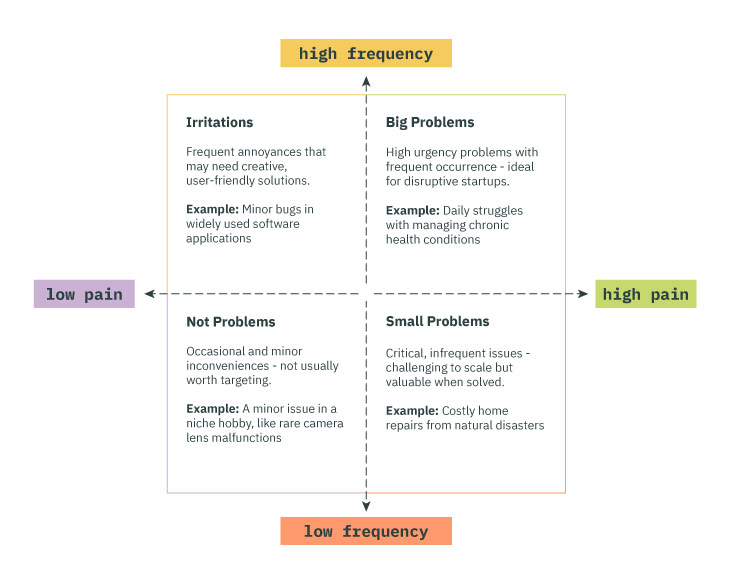Identifying a startup idea that’s worth pursuing is one of the foundational steps toward success in entrepreneurship. But, how can entrepreneurs be sure they’re focusing on issues that truly matter to their potential customers? Enter the Pain Frequency Matrix – a powerful tool that can help startup founders evaluate and prioritize their ideas based on real-world impact. In this guide, we outline what entrepreneurs need to know about this valuable framework and how to leverage it to evaluate and refine their startup idea.
What Is the Pain Frequency Matrix?
The Pain Frequency Matrix is a framework used by entrepreneurs and business strategists to assess potential startup ideas or business opportunities. At its core, this matrix helps categorize problems based on two critical factors:
- Frequency: How often does the problem occur for potential users?
- Pain: How severely does the problem affect users when it does occur?
By plotting potential problems or ideas on this matrix, entrepreneurs can quickly visualize which issues are most worth solving from a business perspective. The matrix typically consists of four quadrants, each representing a different combination of frequency and pain intensity.

Let’s dive into each quadrant of the Pain Frequency Matrix to understand what they represent and their implications for startups:
High Frequency, High Pain
This quadrant represents the sweet spot for most startups. Problems that fall into this category occur frequently and cause significant pain or inconvenience. These are the types of issues for which people are most likely to seek out — and purchase — solutions to address.
Examples of high frequency, high pain problems might include:
- Daily commute congestion in major cities
- Difficulty finding affordable childcare
- Chronic health issues that impact daily life
Startups that successfully address problems in this quadrant often have the potential for rapid growth and high user engagement. Users are likely to be highly motivated to adopt and stick with solutions that effectively address these pain points.
High Frequency, Low Pain
Issues in this quadrant occur often, but don’t cause severe problems for users. While these can still represent viable business opportunities, they often require more creative monetization strategies or exceptional execution to succeed.
Examples might include:
- Minor inconveniences in everyday software tools
- Slightly inefficient processes in common tasks
- Small annoyances in product designs
Startups tackling these problems may need to focus on creating highly polished, user-friendly solutions that make life noticeably easier or more pleasant. The challenge here is often in convincing users that the improvement is worth paying for or worth the hassle of switching from existing solutions.
Low Frequency, High Pain
This quadrant represents problems that are severe when they occur, but that don’t happen very often. These can be tricky for startups because while there’s a clear need for solutions, the market size may be limited.
Examples could include:
- Rare, but serious medical conditions
- Infrequent, but costly home repairs
- Once-in-a-lifetime legal issues
Startups focusing on these problems often need to have a clear strategy for reaching their niche market efficiently. They may need to charge premium prices to compensate for the smaller user base or find ways to expand their offerings to related, more frequent problems.
Low Frequency, Low Pain
The final quadrant represents problems that neither occur frequently nor cause significant issues when they do. Generally, these aren’t attractive opportunities for startups because people likely have little motivation to seek out or pay for solutions.
Examples might include:
- Extremely niche hobbies or interests
- Minor inconveniences to which people have already adapted
- Problems that only affect a very small subset of people infrequently
While there may be exceptions, startups are generally advised to avoid focusing on problems in this quadrant unless they have a compelling reason to believe they can create significant value despite the low frequency and pain levels.
How to Use the Pain Frequency Matrix
Now that you understand the components of the Pain Frequency Matrix, let’s explore how entrepreneurs can effectively use this tool to evaluate and refine their startup ideas. This typically involves eight steps:
1. Identify Potential Problems
Begin your journey by casting a wide net to capture a diverse array of problems and pain points within your area of interest. Gather your team for spirited brainstorming sessions, encouraging wild ideas alongside practical ones. Complement these internal insights with external perspectives by engaging directly with potential customers through interviews and surveys. Immerse yourself in the broader context of your industry by analyzing trend reports, customer feedback, and online forums where your target audience congregates. At this stage, prioritize quantity over quality; you’ll have ample opportunity to refine and filter your ideas as you progress.
2. Assess the Frequency
With your list of potential problems in hand, determine how often each issue occurs for your prospective users. Combine quantitative and qualitative methods to paint a comprehensive picture. Conduct market research, analyze online search trends, and deploy targeted surveys to your demographic of interest. Examine usage patterns of existing products or services in your space, and consult academic studies or industry reports for a broader perspective. Strive to quantify frequency in concrete terms. For instance, “occurs daily for 60% of users” provides a much more actionable insight than a vague label like “high frequency.”
3. Evaluate the Pain Level
Assess the severity of each problem’s impact when it arises. Arrange in-depth interviews with individuals from your target market, creating a safe space for them to share their frustrations and experiences. Employ empathy mapping techniques to dig deeper into the underlying feelings and motivations driving user behavior. Analyze the financial costs, time expenditure, and potential ripple effects each problem creates. To bring structure to this inherently subjective assessment, consider developing a consistent scale across all identified problems (e.g., using a one to 10 range where one represents a minor annoyance and 10 signifies a critical, life-altering issue).
4. Plot on the Matrix
Bring your data to life on the Pain Frequency Matrix. Create a clear visualization with “Frequency” on one axis and “Pain” on the other, plotting each problem as a distinct point. Consider using colors or sizes to represent additional factors like market size or your team’s expertise. If working with a team, turn this into a collaborative event. The discussions that arise as you collectively visualize your data can spark valuable insights and ensure alignment in understanding the problem landscape.
5. Prioritize High Frequency, High Pain Problems
Focus on the upper-right quadrant — the sweet spot where high frequency meets high pain. These problems represent your most promising opportunities for creating a successful startup. Rank them based on additional factors, such as market size, competitive landscape, or your team’s unique capabilities. Select the top two or three problems for further validation and development, allowing you to devote adequate resources to thoroughly exploring each opportunity.
6. Refine Your Ideas
Don’t dismiss ideas that didn’t immediately land in the ideal quadrant. Instead, view these as opportunities for refinement and creative problem-solving. Could you expand the problem definition to increase its frequency or pain level? Is there a specific user group for whom this problem is particularly acute? Consider bundling multiple low-pain problems into a comprehensive solution or explore ways to increase the need to use a solution for a high-pain, but low-frequency problem. This stage often involves lateral thinking and may lead to exciting pivots that transform a seemingly unpromising idea into a compelling opportunity.
7. Validate With Potential Users
Put your assumptions to the test by engaging directly with potential users. Conduct focused interviews that delve deeply into the specific issues you’ve identified. Create landing pages or ads for hypothetical solutions to gauge interest and gather data on user intent. Develop minimum viable products (MVPs) or prototypes for user testing, providing tangible experiences to which users can react. Consider running small-scale pilot programs or beta tests that simulate real-world usage of your proposed solution. Throughout this validation process, employ techniques like the “Mom Test” to ensure you’re gathering genuine, unbiased feedback rather than simply confirming your own assumptions.
8. Iterate and Refine
As you accumulate insights from your validation efforts, be prepared to revisit and adjust your initial assessments. Regularly update your Pain Frequency Matrix with new data and insights, allowing it to serve as a living document that reflects your growing knowledge. Be willing to let go of ideas that don’t stand up to real-world scrutiny. Look for patterns or trends in how your assessments change over time because these can often point to underlying truths about your market that weren’t immediately apparent. Use this iterative process to continually hone in on the most promising opportunities, refining your focus as you go.
Conclusion
By systematically using the Pain Frequency Matrix, entrepreneurs can gain valuable insights into which problems are most worth solving. This approach helps focus limited resources on ideas with the highest potential for success and impact.
It’s important to note that the Pain Frequency Matrix is just one tool in the entrepreneur’s toolkit. You should use it in conjunction with other methods of idea validation, market research, and business planning. However, for many startups, it can provide a crucial first step in refining their focus and increasing their chances of solving problems that truly matter to their target users.

